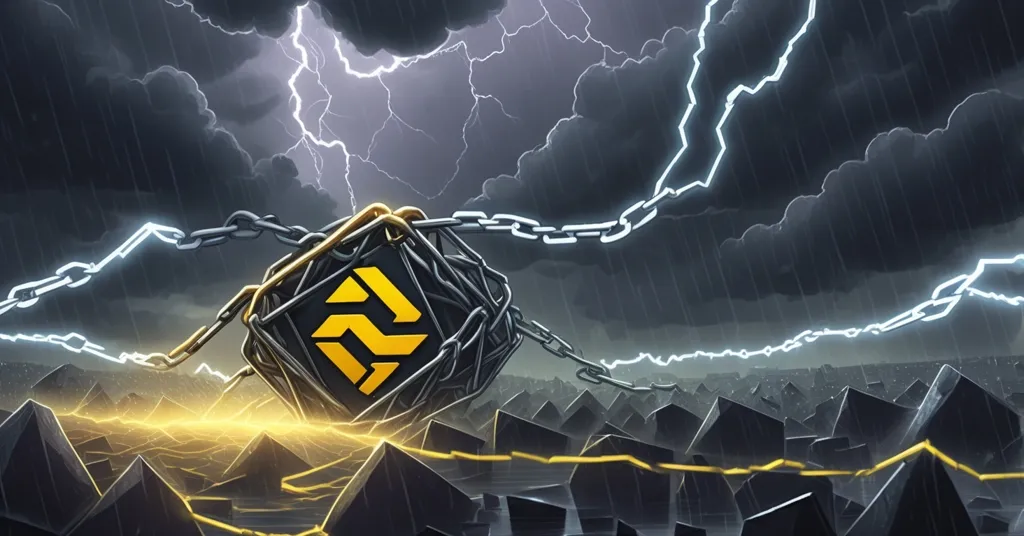Chainlink’s $149M Binance Transfer Sparks Sell-Off Fears: Crisis or Hidden Rally?

Chainlink’s $149 Million Binance Transfer: Sell-Off Panic or Hidden Opportunity?
Chainlink (LINK), a heavyweight in decentralized finance and Web3 infrastructure, is caught in a brutal storm. With a price drop of over 30% since May, now lingering around $11.80, and a massive transfer of 17.875 million LINK—worth roughly $149 million—to Binance, the crypto community is on edge. Is this a prelude to a devastating sell-off, or could history repeat with a surprise rally post-unlock? Let’s unpack the chaos.
- Price Crash: LINK down over 30% since May, trading at a low of $11.80.
- Huge Transfer: $149 million in LINK moved to Binance, fueling sell-off fears.
- Market Headwinds: Bitcoin dominance and global uncertainty hammer altcoins.
The $149 Million Binance Transfer: Sell-Off or Strategic Play?
Here’s the bombshell that’s got everyone talking: on-chain data from Lookonchain revealed that 17.875 million LINK, valued at approximately $149 million, was shifted from non-circulating supply wallets to Binance, the biggest centralized crypto exchange out there. Non-circulating supply, for those new to the game, refers to tokens that are typically locked up—think team allocations, partnership funds, or ecosystem development reserves. These are often released in scheduled events known as token unlocks. When a chunk this big hits an exchange, the knee-jerk reaction is to brace for a dump. Why else would someone park that much value on Binance if not to cash out? For more on this massive movement, check out the detailed report on Chainlink’s $149 million transfer to Binance.
Backing up the concern, BeInCrypto reported a broader wave of LINK exchange inflows this week, totaling around $225 million. That includes a separate transfer of 1.9 million LINK, worth about $25 million, flagged by Whale Alert. That’s a mountain of tokens potentially waiting to flood the market. Representing roughly 2.9% of LINK’s circulating supply of 608 million tokens (as of recent data), this transfer isn’t pocket change—it’s a seismic event that could sway price action if sold off. For context, large inflows to exchanges often signal intent to liquidate, especially during bearish market conditions, and the optics here are anything but rosy. To understand the historical impact of such unlocks, take a look at this analysis of Chainlink token unlocks and price trends.
But hold the panic button. This isn’t Chainlink’s first rodeo. Since 2022, the project has undergone eleven major token unlocks, and the aftermath hasn’t always been a bloodbath. Take mid-2022, for instance—after a significant unlock, LINK rebounded about 15% within a month as DeFi projects snapped up the new supply for their oracle needs. The logic is straightforward: if underlying demand exists, the market can absorb the extra liquidity without cratering the price. So, while the immediate sentiment screams “sell-off incoming,” history whispers that a recovery isn’t out of the question—if the stars align.
Why Altcoins Like LINK Are Getting Crushed
Chainlink’s woes aren’t happening in a vacuum. The broader crypto market is caught in a perfect storm of misery, and altcoins—cryptocurrencies other than Bitcoin—are taking the hardest hits. Bitcoin dominance, which measures BTC’s share of the total crypto market cap, has spiked to around 57-58% recently. Think of it as the greedy big brother hogging all the allowance money. When dominance climbs, capital flows disproportionately into Bitcoin, often seen as a safer bet during uncertainty, leaving tokens like LINK starved for investment. The result? LINK’s price has reverted to levels last seen in early November 2023, erasing months of gains. For deeper insights into this trend, explore this expert analysis on Bitcoin dominance and altcoin markets.
Zoom out further, and the picture gets uglier. Global financial chaos is piling on the pressure. Rising US Treasury yields signal that investors are flocking to safer assets as the Federal Reserve plays cautious with interest rates, unwilling to slash them aggressively amid inflation fears. Geopolitical unrest in the Middle East, with tensions involving key players like Iran and Israel, isn’t just a news headline—it’s spiking oil prices, stoking inflation concerns, and pushing capital away from risky plays like crypto into traditional havens. For speculative assets like altcoins, this risk-off sentiment is a death knell, at least in the short term.
Chainlink isn’t alone in this struggle. Other altcoins like Cardano (ADA) and Polkadot (DOT) are also bleeding, with similar double-digit losses over recent months. But LINK’s niche as a decentralized oracle network means its pain might cut deeper—unlike general-purpose blockchains, its value is tied to specific use cases in DeFi and Web3, which are themselves under pressure as liquidity dries up. It’s a vicious cycle, and right now, altcoins are on the losing end. If you’re curious about the broader community sentiment on this transfer, check out this Reddit discussion on Chainlink’s Binance transfer.
Chainlink’s Fundamentals: Still a DeFi Powerhouse?
Let’s shift gears and talk about why Chainlink isn’t just another altcoin destined for the graveyard. At its core, Chainlink is a decentralized oracle network—a fancy way of saying it’s the internet’s translator for blockchains. Smart contracts, the self-executing agreements powering DeFi on platforms like Ethereum, can’t directly access real-world data like stock prices, weather updates, or sports scores. Chainlink bridges that gap, feeding reliable data into these contracts and enabling everything from lending protocols to insurance payouts. The native token, LINK, fuels this system by incentivizing data providers and securing the network. For a comprehensive overview, refer to the Chainlink decentralized oracle network wiki.
Chainlink’s dominance in this space is no small feat. It powers price feeds for major DeFi platforms like Aave and Synthetix, provides proof-of-reserves for stablecoin issuers like Tether (ensuring they actually hold the assets they claim), and facilitates cross-chain interoperability through tools like CCIP (Cross-Chain Interoperability Protocol). Its partnerships span from Ethereum-based projects to traditional finance giants exploring blockchain integration. Recent updates to Chainlink 2.0, including staking mechanisms, further bolster its security and decentralization by allowing LINK holders to lock up tokens and earn rewards—think of it as a savings account with benefits for the network. To dive deeper into its role and recent price challenges, see this Chainlink’s DeFi oracle role and price drop analysis.
Even in a bear market, on-chain metrics show growth in Chainlink’s integrations. Stablecoin issuers and cross-chain protocols continue to lean on its oracles, and if regulatory frameworks in the US or EU tighten around stablecoins—demanding transparency through proof-of-reserves—Chainlink could see a surge in demand. Compared to competitors like Band Protocol or API3, LINK’s market share and ecosystem are leagues ahead. So, while the price chart looks like a horror show, the underlying value proposition remains rock-solid. The question is whether the market can see past the immediate noise to bet on this long-term potential.
Technical Outlook: More Pain on the Horizon?
Now for the cold, hard numbers—and they’re not pretty. Chainlink’s price, hovering around $11.80, has smashed through key support levels, including the psychological $12 mark that traders often watch as a line in the sand. Support levels are like price floors where buyers historically step in to defend against further drops, but once broken, they signal weakness. Adding to the gloom, LINK is trading below its 50-day, 100-day, and 200-day simple moving averages (SMAs). For the uninitiated, SMAs are tools traders use to track price trends over time—when the price sits below these lines, it’s a classic sign of a continuing downward spiral. For a detailed breakdown of the market impact of such transfers, read this Chainlink transfer market impact analysis.
Other indicators aren’t much brighter. The Relative Strength Index (RSI), which measures whether an asset is overbought or oversold, is flirting with oversold territory but hasn’t yet signaled a definitive bottom. Volume trends show selling pressure outweighing buying interest, reinforcing the bearish momentum. For the veterans among us, this setup screams caution—there’s no clear reversal pattern yet. And for the newcomers, a word of warning: technical analysis in crypto is a shaky game at best. Markets this volatile can defy charts faster than you can say “black swan.” If LINK can’t reclaim $12 soon, we might see a slide toward lower levels from late 2023. Buckle up.
The Centralization Conundrum: A Flaw in the Armor?
Let’s play devil’s advocate for a moment, especially for the Bitcoin maximalists in our crowd. Chainlink champions decentralization, yet here we are, fretting over a massive transfer to Binance—a centralized exchange with a history of regulatory scrutiny and questionable optics. If a project’s ethos is about cutting out middlemen and empowering peer-to-peer systems, shouldn’t it be less vulnerable to the whims of a single platform? This $149 million move highlights a tension: for all its decentralized tech, Chainlink’s token distribution and liquidity often rely on centralized hubs. That’s a gut punch to purists who see Bitcoin’s resilience—built on a network of nodes with no central point of failure—as the gold standard.
There’s more to chew on. Large exchange inflows like this can spark whispers of market manipulation. If a whale dumps on retail investors, it’s not just a price hit—it’s a trust hit. And with Binance’s past run-ins with regulators, there’s always the lingering risk that centralized platforms could face crackdowns, freezing assets or disrupting liquidity. Compare that to Bitcoin, which thrives as a store of value in uncertain times partly because it sidesteps these choke points. So, while Chainlink’s utility is undeniable, this centralization snag raises fair questions about whether it can fully embody the decentralized future we’re fighting for.
What If? Catalysts That Could Spark a Rally
Enough with the doomscrolling—let’s speculate on what could turn the tide for Chainlink. Imagine a major partnership announcement drops, say, a top-tier bank adopting Chainlink’s oracles for blockchain-based settlements. Or picture a shift in global sentiment—maybe the Fed hints at rate cuts, reigniting risk-on behavior. Even regulatory tailwinds, like stricter stablecoin rules in the US or EU boosting demand for Chainlink’s proof-of-reserves, could flip the narrative. These aren’t guarantees, but they’re plausible triggers that could jolt LINK out of its slump.
More broadly, Chainlink’s tech is a poster child for effective accelerationism—the idea of speeding up innovation to disrupt broken systems. Its oracles are accelerating blockchain adoption in DeFi and traditional finance faster than legacy players can adapt. If the market wakes up to this, even a bearish cycle could be a blip in a longer arc of growth. Altcoins like LINK fill niches Bitcoin isn’t designed for, like real-world data for smart contracts, reminding us that while BTC is king, the ecosystem needs diversity to thrive.
Key Questions and Takeaways for Chainlink’s Future
- What’s driving Chainlink’s 30%+ price drop since May?
A brutal mix of Bitcoin dominance siphoning capital from altcoins, rising US Treasury yields, Federal Reserve caution, and geopolitical unrest in the Middle East has crushed risk appetite for tokens like LINK. - Does the $149 million Binance transfer mean a sell-off is imminent?
It’s a strong possibility—large exchange inflows often signal selling intent, though past unlocks have sometimes sparked recoveries if demand absorbs the new supply. - How does Bitcoin dominance hurt altcoins like LINK?
With Bitcoin claiming 57-58% of the crypto market cap, investors prioritize BTC as a safe haven, leaving altcoins like LINK with shrinking liquidity and plummeting prices. - Can Chainlink’s fundamentals outweigh short-term bearish pressure?
Long-term, absolutely—its dominance in DeFi oracles and integrations with TradFi are unmatched, but near-term recovery depends on a return of risk-on sentiment across markets. - Is Chainlink’s reliance on centralized exchanges a weakness?
Yes, it’s a glaring issue; for a project rooted in decentralization, leaning on platforms like Binance creates trust and regulatory risks that clash with its core mission. - How does Chainlink drive DeFi and Web3 innovation?
By acting as a bridge between blockchains and real-world data, Chainlink enables smart contracts to power DeFi lending, insurance, and stablecoins, paving the way for a decentralized future.
What to Watch Next for Chainlink
As this saga unfolds, keep an eye on a few critical developments. Further token unlocks or exchange inflows could intensify selling pressure, while on-chain data like staking growth in Chainlink 2.0 or new partnerships might signal a turnaround. Broader market shifts—think Federal Reserve moves or easing geopolitical tensions—will also play a role. A word of caution: beware of scams. High-profile news like this often spawns fake Chainlink airdrops or phishing schemes on social media. Stick to verified sources, and don’t fall for too-good-to-be-true promises.
Chainlink stands at a crossroads. The $149 million Binance transfer and bearish technicals paint a grim short-term picture, compounded by macro conditions that are anything but friendly. Yet, its role as DeFi infrastructure can’t be understated—this isn’t hype-driven fluff; it’s a linchpin of blockchain’s future. Whether it holds ground or slides further hinges on the market’s ability to look beyond fear and bet on utility. Volatility is crypto’s middle name, so stay sharp. This space doesn’t reward the naive, and Chainlink’s next chapter will be a raw lesson in survival versus value.



